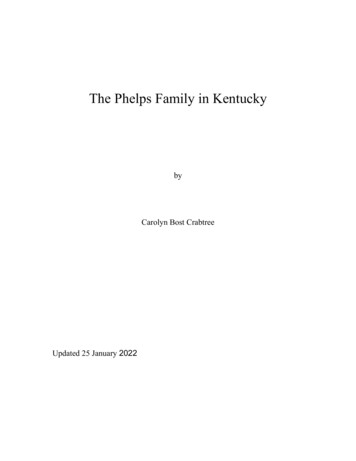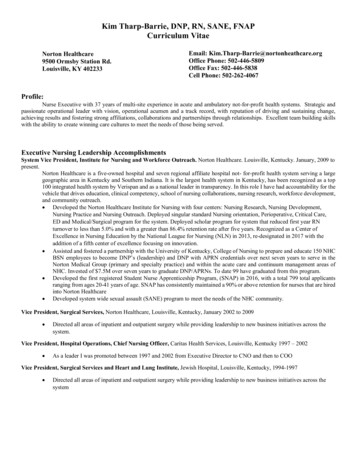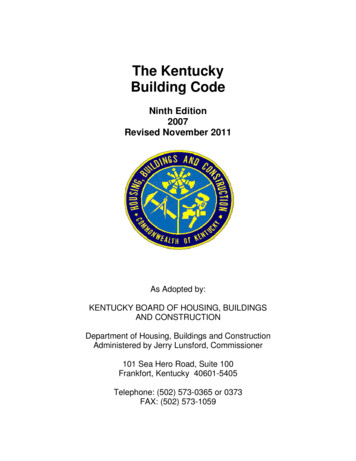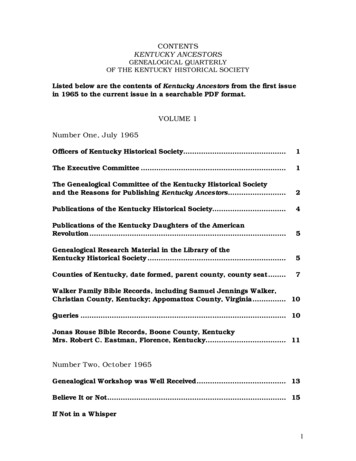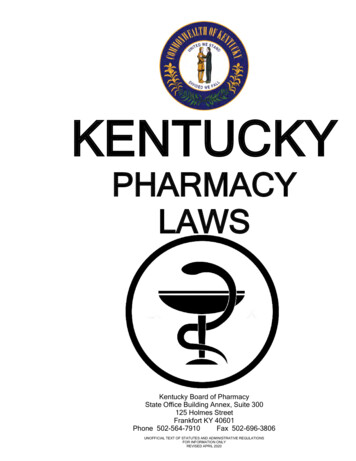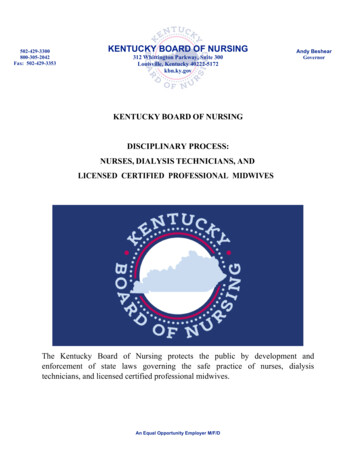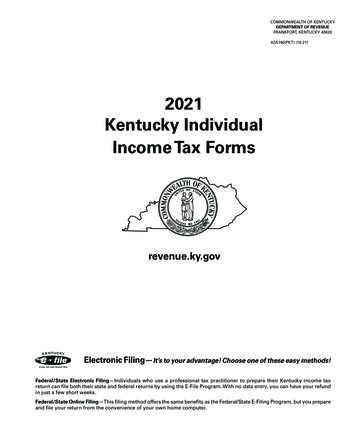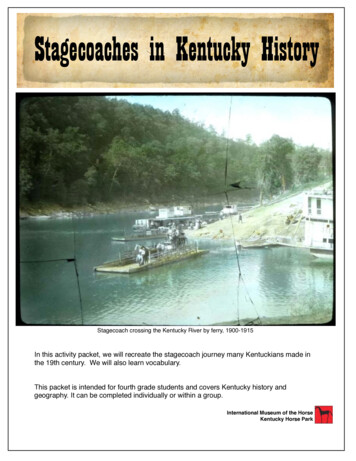
Transcription
Stagecoaches in Kentucky HistoryStagecoach crossing the Kentucky River by ferry, 1900-1915In this activity packet, we will recreate the stagecoach journey many Kentuckians made inthe 19th century. We will also learn vocabulary.This packet is intended for fourth grade students and covers Kentucky history andgeography. It can be completed individually or within a group.International Museum of the HorseKentucky Horse Park
For teachers: Common Core Standards2SS-04-2.1.1Students will identify early cultures (Native American, Appalachian,pioneers) in Kentucky and explain their similarities and differences.Table of Contents:1.Background Information2.Stagecoaches in Kentucky3.Life on the Stagecoach4.Concord Coach5.Age of Stagecoaches andits End6.Create a map of Kentucky!SS-4-GC-S-1 (b)Explain and give examples of services state governments provide (e.g., statepolice and fire protection, state parks, highway maintenance, snow removal)SS-04-4.3.2Students will describe how advances in technology (e.g., dams, reservoirs,roads, irrigation) allow people to settle in places previously inaccessible inKentucky.SS-04-4.4.1Students will explain and give examples of how people adapted to/modifiedthe physical environment (e.g., natural resources, physical geography,natural disasters) to meet their needs during the history of Kentucky andexplain its impact on the environment today.SS-04-4.4.2Students will describe how the physical environment (e.g., mountains asbarriers or protection, rivers as barriers or transportation) both promotedand restricted human activities during the early settlement of Kentucky.SS-04-5.2.3Students will compare change over time in communication, technology,transportation and education in Kentucky.Below is an image of the stagecoach that traveled from Monticello to Burnside, Kentucky
!For well over a century of American History (19th centuries), the stagecoach served asthe main mode of transportation. Stagecoaches, or simply coaches, delivered goods, mail,and passengers to cities and towns throughout the eastern United States and later out west.Up to nine people, including the driver, could fit in the larger coaches, and some trips couldtake days or even weeks to reach their destination. Stagecoaches could travel at about tenmiles per hour. Riding horseback was much faster, but one could not carry nearly as muchcargo. Riding in a coach was much different than our experience riding in cars today.Coaches could not have glass windows, as the rocky and rough roads would have brokenthem. Leather shades on the windows would block sunlight, but dust, heat and cold wouldmake the trip very unpleasant. Also, the lack of seat belts would cause you to bump into theperson seated next to you constantly.The Beginning of InfrastructureSo how were the roads for Stagecoaches developed? Highways androads today are public property, or owned by the government. With theunsettled lands of the early United States, many routes would passthrough private properties. Stagecoach companies paid a toll* to landowners to pass through their property, and in return, the landowners woulddevelop and maintain adequate roads for them to pass. These “roads”were often very muddy and difficult for travel. The Kentucky statelegislature saw a need for improved “stagelines” and budgeted funds forroad improvement in 1795. Many roads would still be closed off during thewinter months, and horseback was still the preferred method of travel untilseveral years later when the road quality improved.Did you know?Mary Todd Lincoln’s grandfather, General Levi Todd, was the first person inLexington to own a carriage.What is the difference between a carriage and a stagecoach?A stagecoach is meant for long trips and are generally more rugged and strongerthan carriages. Carriages have thinner wheels and are primarily meant for travelwithin a town or city, such as a trip to the grocery store. Think of the tires of amountain bike versus a street bike. The mountain bike has thicker tires and ismore durable.StagecoachCarriage3
4On Wednesday, August 9, 1803, a gentleman by the name ofJohn Kennedy opened the first Stage Coach line that ran on aregular schedule. It ran weekly, on Thursdays, and went toOlympian Springs, a popular vacation spot. When diseasebecame a problem in Lexington during the 1830’s, many peoplefrom Lexington went to Olympian Springs to avoid getting sick.Each passenger was allowed to have ten pounds of luggage withthem. Mr. Kennedy was aware that the roads made travel veryuncomfortable, and he spent a lot of money to improve theconditions. From this point on, Lexington citizens could carrymore luggage with them than those who rode on horseback.What was it like to ride in a Stagecoach?As stated before, these trips could be difficult for passengers.Windows lacked protection, except for a piece of leather. Becauseof this, you would get cold in the winter, hot in the summer, and wetduring storms. Many times, the stagecoach would get stuck on theside of the road or in the mud, and passengers would have to getout and help push the coach back onto the road! On overnighttrips, stagecoach drivers would stopover at Inns. Most of the tripsin Kentucky could be made in one day. To do this, these coachesoften left at 4:00 in the morning!Kentucky Gazette, 1803
The Concord CoachThe Best Ride for Travel in KentuckyThe Concord Coach was a major part of Kentucky history, and Kentucky is known forit’s innovations in travel.Shotgun SeatDriver’s SeatLeather flaps to cover thewindows during travelBrake HandleFolding StepsOften the wheels were painted yellow tohide the dust and dirt from the roads.Did you know?Have you ever called “shotgun” in a car? This term is from Kentucky! The Shotgun Seat on theConcord Coach was right next to the driver, and this person was responsible for the coach’ssecurity. The person in the Shotgun Seat would protect the passengers from thieves andAmerican Indians. Both were big risks in early Kentucky history!
The Age of Stagecoaches and its EndStagecoaches were the main form oftransportation for a few decades until theRailroad, which was much quicker, came toKentucky.Below are the average times the Stagecoachwould take to travel within Kentucky: Lexington to Frankfort 4 hours Lexington to Louisville 11 hours Lexington to Covington 11 hours Lexington to Paris 2 hours Louisville to Nashville 33 hours Louisville to Frankfort 7 hoursThe End of the Stagecoach EraThe first successful railroad in Central Kentuckyopened in 1848 and ran from Lexington toFrankfort. The last “stage” to run in all ofKentucky ran from Burnside to Monticello in1915. Railroads offered a smoother travel andpassengers could carry more luggage. Peoplecontinued to use carriages within towns andcities, as passengers would need to get to theirfinal destination from the railroad station.
Activities and VocabularyLexington History Timeline1789TransylvaniaCollege isfounded1775LexingtonFounded inVirginia Colony1792KentuckyConstitution ratifiedand Lexington is nowin Kentucky.18331915Illness spread inLexington, andmany people fled toOlympian SpringsThe lastStagecoach Lineran from Burnside toMonticello1803John Kennedyopens firststagecoach linegoing to OlympianSprings18771848First Railroad lineopens, going fromLexington toFrankfortThe lastStagecoach stopsrunning, fromLexington toHarrodsburgVocabulary1. Carriage- a four-wheeled passenger vehicle pulled by two or more horses: ahorse-drawn carriage. (Mainly used for travel within a town or city)2. Era- a long period of history with a particular feature or theme3. Infrastructure- the basic physical structures and facilities (buildings, roads, andpower supplies)4. Innovation- Invention in technology; make changes in something especially bycreating new methods, ideas, or products5. John Kennedy- gentleman who introduced the first commercial stagecoach linein Central Kentucky, running from Lexington to Olympian Springs6. Olympian Springs- A popular destination in Kentucky, where people in the 19thcentury believed the waters would improve their health. It was a place wherepeople escaped to when illness came to Lexington.7. Ratify- sign or give formal consent to (a treaty, contract, or agreement), makingit official.
Create a Map of Kentucky!Using the map provided, locate the major stopping points within Kentucky stagecoach lines. Also,stagecoaches had a lot of trouble with mountains and rivers, so we will need to locate thefollowing landmarks within Kentucky:1. Appalachian Mountains2. Cumberland Mountains3. Ohio River4. Kentucky RiverLandmarks and Cities on the Line Stops:1. Lexington2. Louisville3. Covington4. Olympian Springs5. Harrodsburg6. Paris7. FrankfortQuestions:1. By looking at your finished map, did the mountains and rivers make it hard to get aroundKentucky? Why?2. What regions of Kentucky were most popular for stagecoaches?
Olympian SpringsName: Date:Stagecoach Lines in Kentucky
Kentucky. Below are the average times the Stagecoach would take to travel within Kentucky: Lexington to Frankfort 4 hours Lexington to Louisville 11 hours Lexington to Covington 11 hours Lexington to Paris 2 hours Louisville to Nashville 33 hours Louisville to Frankfort 7 hours The End of the Stagecoach Era

